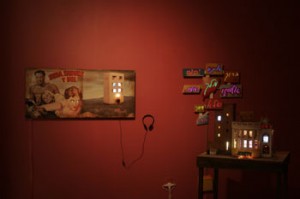« Reviews
Tracey Snelling
PanAmerican Art Projects - Wynwood Art District, Miami
November 29, 2008 - January 31, 2009
By Arelys Hernández
Since Pop Art arose to occupy a fundamental place in the history of American art, many subsequent offerings have carried its imprint, or at least, some of its processes and symbols from advertising iconography, industrial merchandise; a landscape marked by urban culture; the use of photography as a basis for visual construction. There was even a second phase of this movement of aesthetic change, known as Neo Pop, which in the decade of the 80’s unleashed diverse imaginative production that - apart from using advertisements, comic strips, references to everyday places and objects - took on the language of media (from television, movies, etc.), using various styles and techniques of artistic creation.
There is no doubt that combine painting, the environment and the Neo Pop aesthetic have had an influence on the artist, Tracey Snelling, as evidenced by her exhibition pieces at the PanAmerican Art Projects gallery (November 29, 2008 - January 31, 2009). A certain closeness of spirit with the aforementioned figurative concepts - above all with George Segal and Duane Hanson - underlay the collection of works in which she mixed different materials and solutions from various disciplines. The direct reflection of her perceptions as a photographer and a formal criterion identified with crude art and naive vision were displayed. Her case is one of an artist who opts for an installative and intergeneric oeuvre, integrating the sculptural with the pictorial, informational design, scale models and props.
Tracey led the spectators to encounter what she saw and experienced in her travels through urban and rural landscapes. However, she did not present simple ocular testimony, but rather a composite of images in two or three dimensions, which sprang from a kind of “psychological distancing,” manifesting her ironic thoughts on referenced reality. The exhibition was comprised of buildings in a state of disrepair, through whose windows one was able to discover the occupations and diversions of its denizens; autos and billboards reminiscent of all kinds of perception or which sacralized screen legends; ordinary people and a series of objects loaded with emotional significance and playful connotation. The exhibition spilled over onto the exterior of the gallery with the display of a large neon sign - HERE - this word functioning as an indicator of “the poetic nature of the social space” mounted by Snelling.
Through a mesh of videos, photos, miniaturized scale models of hotels and motels, fake landscaping, media players, speakers, transformers, screws, LCD screens, electroluminescent wires, etc., Tracey Snelling’s unique multimedia sculptures allowed the public, who contemplated them, to feel the artistic effects of the conceptual confrontation between the artist’s distinctive sensory experience and anthropological valuation. Also notable in her works was a version of “trans-art” that used elements of kitsch and Jung-culture to create a language suited to her situation and our time.
Arelys Hernández: Graduated in Art History (University of Havana). Director and Curator of TeatroAreaStage Gallery in Miami.
Filed Under: Reviews



































